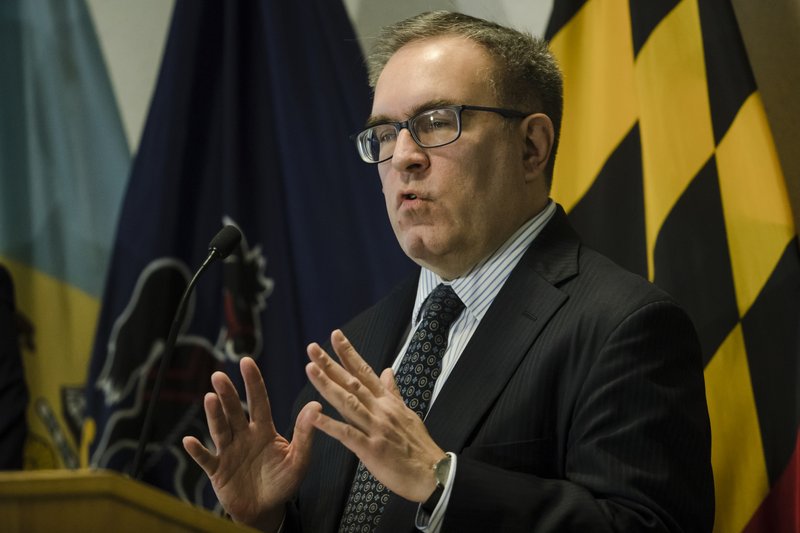Under pressure from Congress, the Environmental Protection Agency said Thursday it would move toward setting safety limits for a class of highly toxic chemicals contaminating drinking water around the country. Environmentalists, congressional Democrats and state officials countered that the agency wasn't moving fast enough.
Acting EPA Administrator Andrew Wheeler released an "action plan" for dealing with the long-lasting substances, which have been linked to health threats ranging from cancer to decreased fertility. The perfluoroalkyl and polyfluoroalkyl substances, known collectively as PFAS, have turned up increasingly in public water systems and private wells.
Wheeler said the agency's plan would help communities monitor, detect and address PFAS pollution.
But environmentalists and some members of Congress said the strategy wasn't aggressive enough on dealing with the chemicals, which are found in firefighting foam, nonstick pots and pans, water-repellent clothing and many other household and personal items.
"This is a non-action plan, designed to delay effective regulation of these dangerous chemicals in our drinking water," said Wenonah Hauter, executive director of Food & Water Watch.
Former EPA chief Scott Pruitt described PFAS contamination as a "national priority" and pledged swift action last May. Wheeler has served as the EPA's acting head since Pruitt's resignation in July amid ethics scandals, and the agency's handling of PFAS contamination was raised as an issue in Wheeler's confirmation hearings.
Scientific studies have found "associations" between the chemicals and cancer, thyroid disease, ulcerative colitis and other health issues.
Sen. Tom Carper of Delaware, the top Democrat on the Environment and Public Works Committee, said the EPA plan doesn't include a commitment to set safety limits for the chemicals in drinking water and prolongs the evaluation for at least another year.
"It has taken the EPA nearly a year to just kick the can even further down the road," Carper said. "While EPA acts with the utmost urgency to repeal regulations, the agency ambles with complacency when it comes to taking real steps to protect the water we drink and the air we breathe."
David Ross, assistant administrator for EPA's Office of Water, said the agency intends to set the standards. Doug Benevento, head of the EPA regional office representing a number of Western states, tweeted: "We are moving through the regulatory process required under the Safe Water Drinking Act before we make a determination."
Speaking at a news conference in Pennsylvania, Wheeler said Americans "count on EPA every time they turn on their faucet" and that the agency's plan provides a comprehensive approach to dealing with PFAS.
But Mark Favors, a New York City resident who attended the event and was critical of the plan, said members of his family had been affected by PFAS contamination from an Air Force base in Colorado. Military installations are among the leading generators of the pollutants because of their extensive use of firefighting foam in training exercises.
"My cousin, he did two tours in Iraq. His children drank PFAS for the entire time he was there for the U.S. Army," Favors said. "For an administration that touts that they go above and beyond for the military, I find this a bit underwhelming."
The EPA strategy focuses largely on two of the oldest and most common PFAS chemicals, both of which have been phased out by manufacturers but remain widespread in the environment.
By the end of this year, the EPA will "propose a regulatory determination" for those chemicals, known as PFOS and PFOA, the next step toward establishing limits under the Safe Drinking Water Act, Wheeler said.
Sen. John Barrasso, a Wyoming Republican and chairman of the Senate Environment and Public Works Committee, described the plan as "a first step" but said the EPA "must be willing to take decisive action where it is warranted."
The EPA also is moving toward listing PFOA and PFOS as hazardous substances, which could make them eligible for cleanups under the Superfund program, and will issue interim groundwater cleanup recommendations for contaminated sites, Wheeler said. The agency will propose adding PFAS chemicals to a drinking water monitoring program and develop new methods for detecting them in water, soil and groundwater.
Democratic and Republican lawmakers have pressed him to establish mandatory limits for PFAS in public water systems.
National on 02/15/2019